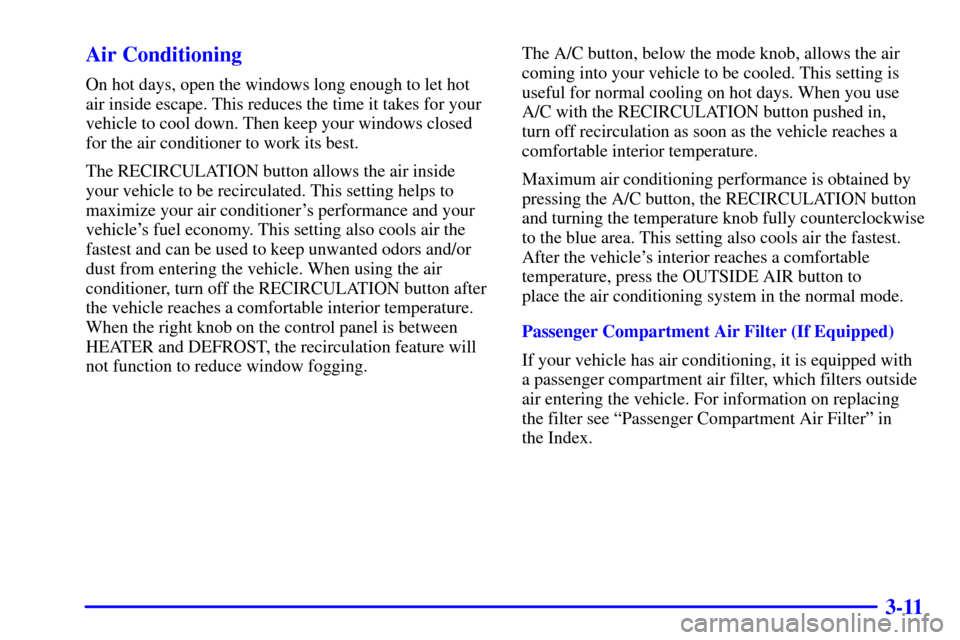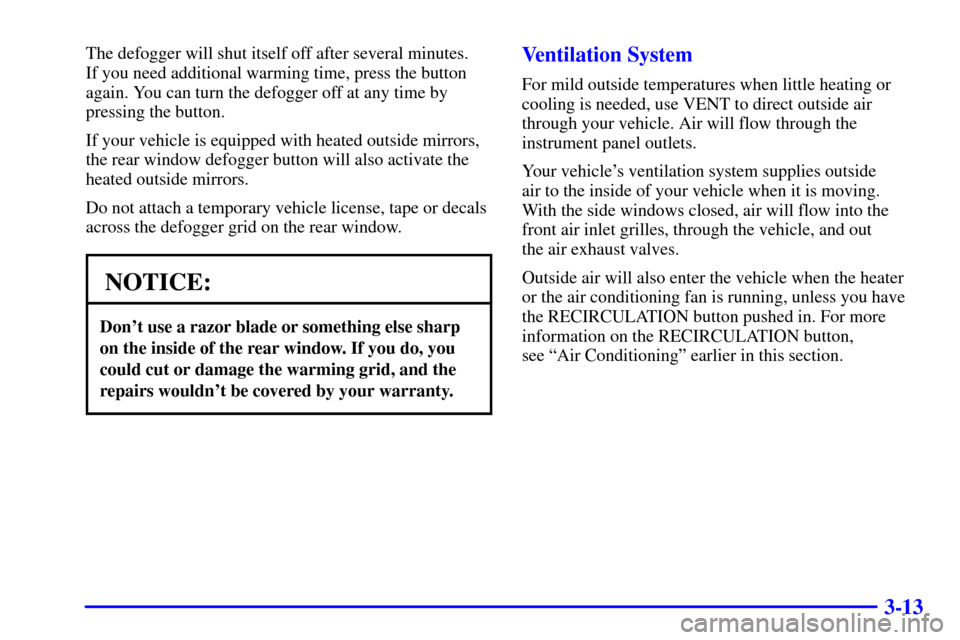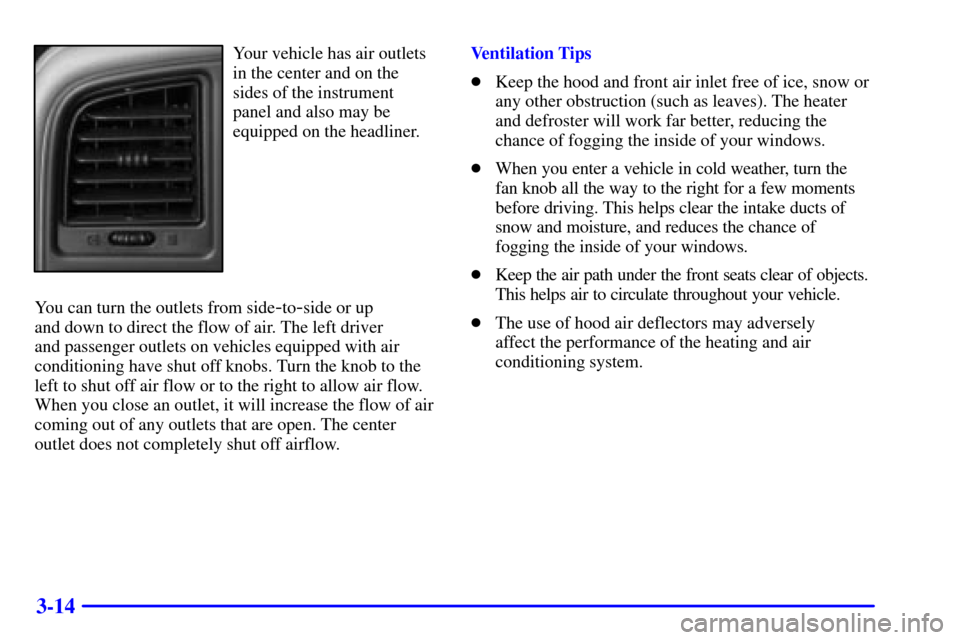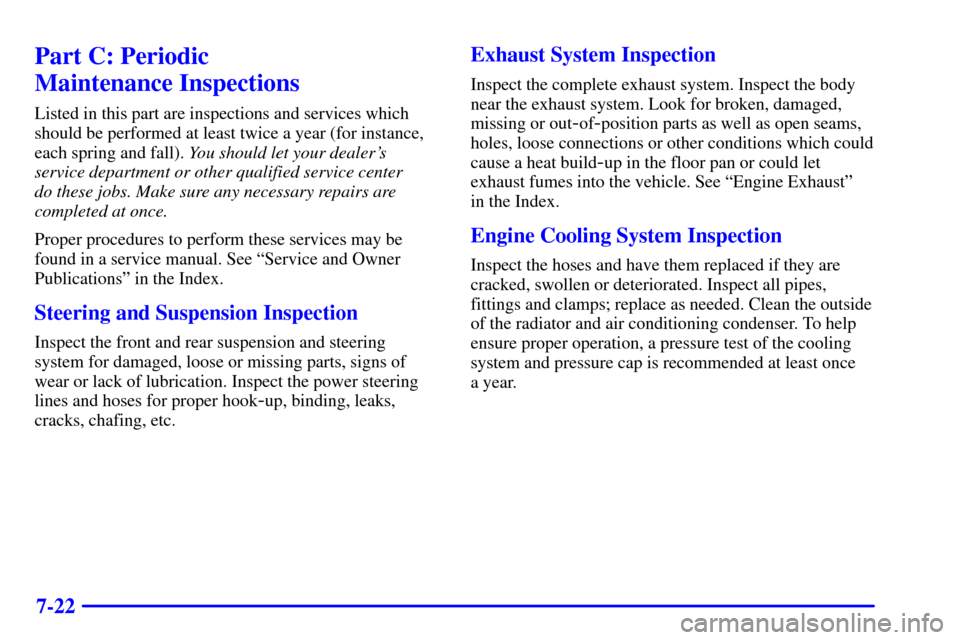Page 177 of 419

3-9
Rear Air Conditioning and Rear Heater
(If Equipped)
If your vehicle has the rear air conditioning and rear
heater system combination, controls are provided to
regulate temperature, location and fan speed.
Front Control
To adjust the airflow speed, turn the fan control knob
located on the left side to the desired setting.
To activate the second seat control system, turn the fan
knob on the front overhead control to REAR.
To regulate the airflow location, adjust the right control
on the control. Turn the knob clockwise for floor vent
airflow or counterclockwise for headliner vent airflow. Generally, the upper vents are used for air conditioning
and the floor vents for heating. The control knob can be
set to any blend setting.
To adjust the air temperature, turn the temperature knob
on the center of the control panel.
For warmer air, turn the knob clockwise toward red. For
cooler air, turn the knob counterclockwise toward blue.
Rear Control
The rear control works just like the front control. It will
allow second seat passengers to adjust the controls as
they desire. To use the rear control, first turn the front
control knob to REAR.
Page 178 of 419

3-10 Rear Air Conditioning and Heating Systems
with Electronic Climate Control System
(If Equipped)
Front Control
Rear ControlWith this system the rear passengers can control the
temperature of the air flow for his/her own zones.
The climate control has three controls.
To adjust the airflow speed, turn the fan control knob
located on the left side of the control panel to the desired
blower setting.
The system also has a front AUTO setting that can
automatically change the temperature of the rear seating
area based on information from the front control. An
OFF setting, located on the front climate control panel,
also allows the driver to turn off the rear passenger seat
controls from the front seat.
To adjust the air temperature, turn the temperature knob
on the center of the control panel.
For warmer air, turn the knob clockwise toward
82�F (28�C). Turn the knob counterclockwise
toward 66�F (19�C) for cooler air.
To regulate the airflow location, adjust the right knob on
the control panel. Turn the knob clockwise for floor vent
airflow or counterclockwise for headliner vent airflow.
Generally, the upper vents are used for air conditioning
and the floor vents for heating. The control knob can be
set to any blend setting.
For rear control operation, use the above instructions.
Page 179 of 419

3-11 Air Conditioning
On hot days, open the windows long enough to let hot
air inside escape. This reduces the time it takes for your
vehicle to cool down. Then keep your windows closed
for the air conditioner to work its best.
The RECIRCULATION button allows the air inside
your vehicle to be recirculated. This setting helps to
maximize your air conditioner's performance and your
vehicle's fuel economy. This setting also cools air the
fastest and can be used to keep unwanted odors and/or
dust from entering the vehicle. When using the air
conditioner, turn off the RECIRCULATION button after
the vehicle reaches a comfortable interior temperature.
When the right knob on the control panel is between
HEATER and DEFROST, the recirculation feature will
not function to reduce window fogging.The A/C button, below the mode knob, allows the air
coming into your vehicle to be cooled. This setting is
useful for normal cooling on hot days. When you use
A/C with the RECIRCULATION button pushed in,
turn off recirculation as soon as the vehicle reaches a
comfortable interior temperature.
Maximum air conditioning performance is obtained by
pressing the A/C button, the RECIRCULATION button
and turning the temperature knob fully counterclockwise
to the blue area. This setting also cools air the fastest.
After the vehicle's interior reaches a comfortable
temperature, press the OUTSIDE AIR button to
place the air conditioning system in the normal mode.
Passenger Compartment Air Filter (If Equipped)
If your vehicle has air conditioning, it is equipped with
a passenger compartment air filter, which filters outside
air entering the vehicle. For information on replacing
the filter see ªPassenger Compartment Air Filterº in
the Index.
Page 181 of 419

3-13
The defogger will shut itself off after several minutes.
If you need additional warming time, press the button
again. You can turn the defogger off at any time by
pressing the button.
If your vehicle is equipped with heated outside mirrors,
the rear window defogger button will also activate the
heated outside mirrors.
Do not attach a temporary vehicle license, tape or decals
across the defogger grid on the rear window.
NOTICE:
Don't use a razor blade or something else sharp
on the inside of the rear window. If you do, you
could cut or damage the warming grid, and the
repairs wouldn't be covered by your warranty.
Ventilation System
For mild outside temperatures when little heating or
cooling is needed, use VENT to direct outside air
through your vehicle. Air will flow through the
instrument panel outlets.
Your vehicle's ventilation system supplies outside
air to the inside of your vehicle when it is moving.
With the side windows closed, air will flow into the
front air inlet grilles, through the vehicle, and out
the air exhaust valves.
Outside air will also enter the vehicle when the heater
or the air conditioning fan is running, unless you have
the RECIRCULATION button pushed in. For more
information on the RECIRCULATION button,
see ªAir Conditioningº earlier in this section.
Page 182 of 419

3-14
Your vehicle has air outlets
in the center and on the
sides of the instrument
panel and also may be
equipped on the headliner.
You can turn the outlets from side
-to-side or up
and down to direct the flow of air. The left driver
and passenger outlets on vehicles equipped with air
conditioning have shut off knobs. Turn the knob to the
left to shut off air flow or to the right to allow air flow.
When you close an outlet, it will increase the flow of air
coming out of any outlets that are open. The center
outlet does not completely shut off airflow.Ventilation Tips
�Keep the hood and front air inlet free of ice, snow or
any other obstruction (such as leaves). The heater
and defroster will work far better, reducing the
chance of fogging the inside of your windows.
�When you enter a vehicle in cold weather, turn the
fan knob all the way to the right for a few moments
before driving. This helps clear the intake ducts of
snow and moisture, and reduces the chance of
fogging the inside of your windows.
�Keep the air path under the front seats clear of objects.
This helps air to circulate throughout your vehicle.
�The use of hood air deflectors may adversely
affect the performance of the heating and air
conditioning system.
Page 373 of 419

6-70
Name Usage
RR DEFOG Rear Window Defogger,
Heated Mirrors (Relay)
RTD Autoride� (Real Time Damping)
RR PRK Right Rear Parking Lamps
ECM B PCM
F/PMP Fuel Pump (Relay)
O2 A Oxygen Sensors
O2 B Oxygen Sensors
LR PRK Left Rear Parking Lamps
RR DEFOG Rear Window Defogger,
Heated Mirrors
HDLP Headlamps (Relay)
TRL PRK Parking Lamps Trailer Wiring
PRIME Not Used
RT HDLP Right Headlamps
DRL Daytime Running Lamps (Relay)
HTD MIR Heated Mirrors
LT HDLP Left HeadlampsName Usage
A/C Air Conditioning
AUX PWR Cigarette Lighter, Auxiliary
Power Outlets
SEO 2 Special Equipment Option Power,
Power Seats, Aux Roof Mnt Lamp
SEO 1 Special Equipment Option Power,
Aux Roof Mnt Lamp,
Cell Phone, Onstar
�
DRL Daytime Running Lamps
A/C A/C (Relay)
FOG LP Fog Lamps
FOG LP Fog Lamps (Relay)
RADIO Audio System, Instrument Cluster,
Climate Control System
CIGAR Cigarette Lighter, Auxiliary
Power Outlets
RT TURN Right Turn Signals
BTSI Automatic Transmission Shift Lock
Control System
LT TURN Left Turn Signals
Page 400 of 419

7-22
Part C: Periodic
Maintenance Inspections
Listed in this part are inspections and services which
should be performed at least twice a year (for instance,
each spring and fall). You should let your dealer's
service department or other qualified service center
do these jobs. Make sure any necessary repairs are
completed at once.
Proper procedures to perform these services may be
found in a service manual. See ªService and Owner
Publicationsº in the Index.
Steering and Suspension Inspection
Inspect the front and rear suspension and steering
system for damaged, loose or missing parts, signs of
wear or lack of lubrication. Inspect the power steering
lines and hoses for proper hook
-up, binding, leaks,
cracks, chafing, etc.
Exhaust System Inspection
Inspect the complete exhaust system. Inspect the body
near the exhaust system. Look for broken, damaged,
missing or out
-of-position parts as well as open seams,
holes, loose connections or other conditions which could
cause a heat build
-up in the floor pan or could let
exhaust fumes into the vehicle. See ªEngine Exhaustº
in the Index.
Engine Cooling System Inspection
Inspect the hoses and have them replaced if they are
cracked, swollen or deteriorated. Inspect all pipes,
fittings and clamps; replace as needed. Clean the outside
of the radiator and air conditioning condenser. To help
ensure proper operation, a pressure test of the cooling
system and pressure cap is recommended at least once
a year.